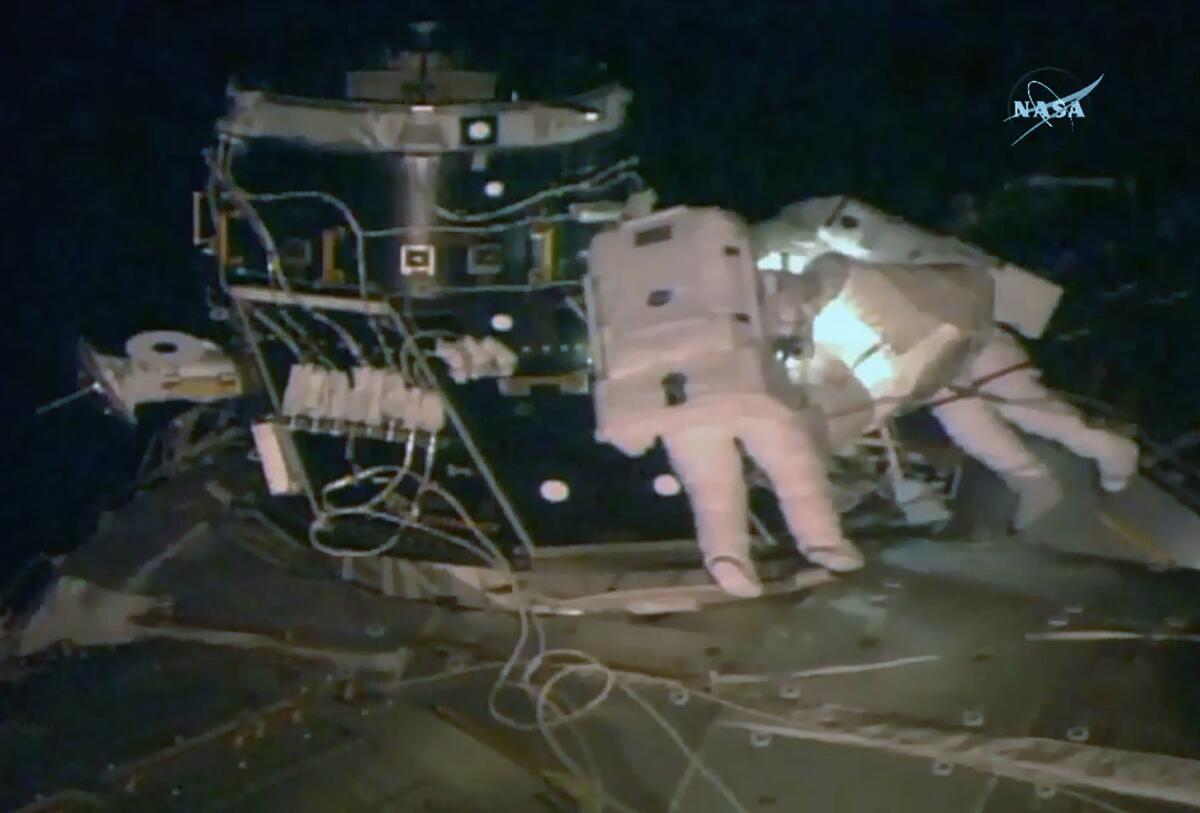Spacewalking astronauts lose a piece of shield needed for International Space Station

Whitson and Shane Kimbrough were installing the shielding over a vulnerable spot on the space station. (March 30, 2017) (Sign up for our free video newsletter here http://bit.ly/2n6VKPR)
- Share via
Reporting from CAPE CANAVERAL, Fla. — Spacewalking astronauts lost an important piece of cloth shielding needed for the International Space Station on Thursday when it floated away.
Astronaut Peggy Whitson immediately reported the mishap to Mission Control, which tracked the bundle as it drifted off. NASA said it would be monitored to make sure it doesn’t come back and hit the station.
The shielding protects against micrometeorite debris. It was one of four pieces that Whitson and Shane Kimbrough were installing over the spot left by a relocated docking port. NASA spokesman Dan Huot said the three remaining shields were installed to cover the most vulnerable spots.

This NASA TV video still shows astronaut Peggy Whitson and Shane Kimbrough outside the International Space Station on March 30, 2017.
It was a disappointing turn of events in a record-setting spacewalk for Whitson, the world’s oldest and most experienced spacewoman. It was the eighth spacewalk of her career, the most performed by a woman. There was frustration in her voice as she informed Mission Control.
Huot said it was not immediately clear who let the shield go or how it got away; it’s supposed to be tethered to the station or spacewalker at all times.
Spacewalkers have lost objects before, but usually the items are small, like bolts. In 2008, an astronaut lost her entire tool kit during a spacewalk.
Each fabric shield weighs 18 pounds. When unfolded, it is about 2 inches thick and measures about 5 feet by 2 feet, according to NASA. The entire 250-mile-high space station is protected, in some fashion, against possible debris strikes.
The docking port was disconnected during a spacewalk last Friday by Kimbrough, the space station’s commander and a six-time spacewalker. Then flight controllers in Houston moved it to a new and better location Sunday. It will serve as one of two parking spots for commercial crew capsules under development by SpaceX and Boeing.
The spacewalkers hooked up vital heater cables to the docking port and removed a cover from the top. Then they turned to the shields, and that’s when one of the folded coverings got away. Mission Control instructed the astronauts to retrieve the cloth cover just removed from the docking port, and try to fashion it over the gaping hole left by the lost shield.
Midway through Thursday’s spacewalk, Whitson was set to surpass the current record for women of 50 hours and 40 minutes of total accumulated spacewalking time, held by former space station resident Sunita Williams. Williams is one of four NASA astronauts who will make the initial test flights of the SpaceX Crew Dragon and Boeing Starliner capsules. The first flight could occur as early as next year.
A Russian holds the all-time spacewalking record: Anatoly Solovyev with 16.
The 57-year-old Whitson has been in orbit since November. This is her third space station stint. Altogether, she’s spent more than 500 days off the planet, also more than any woman.
She’s scheduled to return to Earth in June but may stick around an extra three months, until September. NASA is hoping to take advantage of an extra seat in the Russian Soyuz spacecraft that’s due to launch next month and return in September. A decision is expected soon.
NASA, meanwhile, has indefinitely delayed a spacewalk that had been scheduled for next week. A shipment with replacement parts needed for that spacewalk is on hold because of rocket concerns at Cape Canaveral, Fla. Shipper Orbital ATK is relying on the United Launch Alliance’s Atlas V to haul up the goods.
ALSO
Trump’s budget plan for NASA focuses on studying space, not climate change
Biology explains why men kill big game like Cecil the lion — and how that behavior might be stopped



